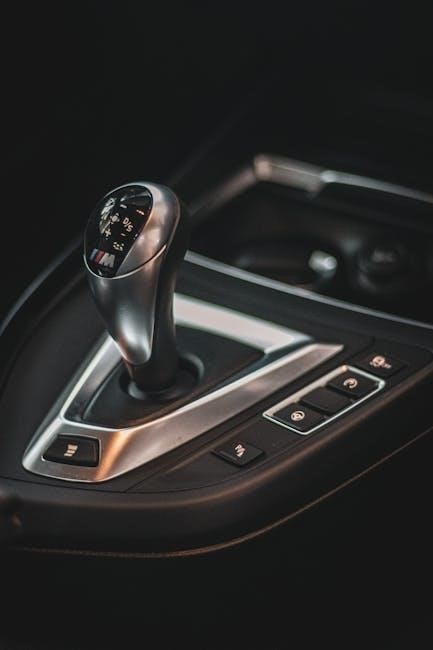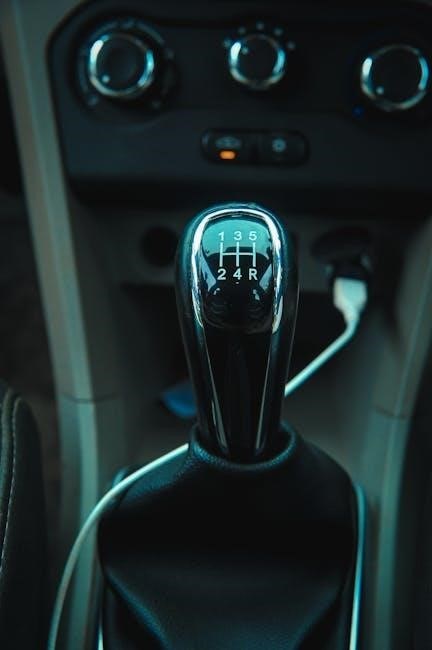LS engines offer versatility for manual transmissions, with options like T56, TR-4050, and NV4500. Each provides unique benefits, balancing strength, gear ratios, and compatibility for diverse applications.
Overview of LS Engine Compatibility with Manual Transmissions
LS engines are highly adaptable to manual transmissions due to their compact design and universal bellhousing pattern. This compatibility makes them ideal for swaps into various vehicles, from classic muscle cars to trucks. The LS series, including Gen III and Gen IV engines, can mate with a wide range of manual transmissions, including the T56, TR-4050, and NV4500. Key factors like torque capacity, gear ratios, and shifter location influence transmission choice. The LS engine’s rear-wheel-drive configuration simplifies integration with manual transmissions, especially when paired with proper adapter kits. Popular setups often include lightweight options like the AX15 for overdrive functionality or heavier-duty units like the NV4500 for high-torque applications. This versatility ensures enthusiasts can tailor their drivetrain to meet specific performance and driving needs.

Popular Manual Transmission Options for LS Swaps
Popular choices include the T56, TR-4050, NV4500, AX15, and TKX. Each offers unique strengths, from strength and torque capacity to budget-friendly overdrive options and modern performance capabilities.
T56 Transmission: The Most Common Choice for LS Engines
The T56 transmission is the most popular choice for LS engine swaps due to its proven durability and widespread availability. Originally featured in 1998-2002 F-bodies and GTOs, this 6-speed manual transmission offers excellent performance capabilities. It is highly compatible with GM muscle cars, requiring minimal modifications for installation. The T56’s bellhousing, flywheel, and clutch pack are readily accessible, making it a favorite among enthusiasts. Swap kits further simplify the process, ensuring a smooth integration into various chassis. Its robust design and optimal gear ratios make it ideal for both street driving and racing applications. The T56 strikes a perfect balance between performance and drivability, solidifying its reputation as the go-to manual transmission for LS swaps. This makes it a top recommendation for those seeking reliability and performance in their builds.
TR-4050 Transmission: A Strong Alternative for High Torque Applications
The TR-4050 transmission is a robust option for LS engine swaps, particularly suited for high-torque applications. Found in GM’s 3500 series trucks, this 5-speed manual transmission is known for its strength and durability. It offers excellent gear ratios for both street driving and heavy-duty use, making it a versatile choice for LS engines producing substantial torque. While not ideal for racing due to its truck-oriented design, the TR-4050 excels in towing and hauling scenarios. Early models may require adapter kits for compatibility with certain chassis, but its reliability and torque capacity make it a strong contender for those seeking a durable manual transmission solution. This transmission is a practical choice for builders prioritizing strength and functionality over lightweight performance.
NV4500 Transmission: A Heavy-Duty Option for Truck-Based Swaps
The NV4500 is a robust 5-speed manual transmission, originally used in GM trucks, making it a popular choice for LS engine swaps requiring high torque capacity. Known for its durability, this transmission is well-suited for heavy-duty applications, such as truck-based swaps, where strength and reliability are paramount. It features a wide range of gear ratios, including a low first gear, which is ideal for towing or hauling. While it may require adapter kits for compatibility with certain chassis, the NV4500 is a reliable option for builders prioritizing strength over lightweight performance. Its truck-oriented design makes it less ideal for racing but highly capable for demanding, real-world scenarios. This transmission is a solid choice for those needing a heavy-duty manual option for their LS-powered projects.
AX15 Transmission: A Budget-Friendly Overdrive Option
The AX15 is a cost-effective 5-speed manual transmission that offers an overdrive gear, making it a practical choice for LS engine swaps. Designed for light-duty applications, it is well-suited for drivers seeking a balance between performance and efficiency. With a compact design and favorable gear ratios, the AX15 is ideal for daily driving and casual performance use. Its overdrive feature enhances fuel efficiency at higher speeds, appealing to those who want a combination of economy and responsiveness. While it may not handle extremely high torque outputs, the AX15 remains a budget-friendly solution for LS swaps, providing a reliable and affordable option for enthusiasts who prioritize everyday usability over extreme performance capabilities.

TKX Transmission: Modern Performance for LS Engines
The TKX transmission is a modern, high-performance 5-speed manual designed for LS engines, offering exceptional strength and durability. Rated for up to 600 lb-ft of torque, it is ideal for both street and track applications. Its optimized gear ratios provide smooth shifting and improved acceleration, while the overdrive feature enhances highway cruising efficiency. The TKX features a compact design, making it compatible with a wide range of chassis configurations. With its robust construction and advanced internal components, this transmission is a top choice for enthusiasts seeking a reliable, high-performance solution without the need for heavy modifications. Its versatility and modern engineering make the TKX a standout option for LS swaps, delivering both power and precision in every drive.
Other Manual Transmission Options: SM465, Muncie, and More
Beyond the popular T56 and TR-4050, enthusiasts can explore other manual transmissions for LS swaps. The SM465, a heavy-duty 4-speed, is known for its strength and durability, making it ideal for high-torque applications. Muncie 4-speeds, such as the M20, M21, and M22, are classic choices, offering simplicity and reliability for vintage builds. Additionally, the AX15 and NV4500, both 5-speeds, provide overdrive capabilities with robust construction, suitable for truck-based swaps. These alternatives offer unique benefits, allowing builders to tailor their drivetrain to specific needs, whether it’s for daily driving, off-road adventures, or racing. With the right adapter kits, these transmissions can be seamlessly integrated into LS engine setups, expanding the possibilities for customization and performance.

Factors to Consider When Choosing a Manual Transmission for LS Swaps
When selecting a manual transmission for LS swaps, consider torque capacity, gear ratios, shifter location, and cost. Compatibility with the chassis and PCM configuration are also crucial.
Torque Capacity and Gear Ratio Selection
Torque capacity and gear ratio selection are critical for LS manual transmission swaps. The transmission must handle the engine’s torque output, especially for high-performance applications. Gear ratios like first gear for acceleration and overdrive for highway efficiency must align with the vehicle’s intended use. For instance, the T56 offers excellent torque capacity and a wide range of gear options, making it suitable for both street and track use. The AX15, while budget-friendly, has lower torque limits, making it better for lighter applications. Proper ratio selection ensures optimal performance, fuel efficiency, and drivability, requiring careful consideration of the vehicle’s weight, tire size, and intended driving conditions. Balancing these factors ensures a seamless and durable manual transmission setup for any LS swap project.
Shifter Location and Chassis Compatibility
Shifter location and chassis compatibility are essential considerations for LS manual transmission swaps. The T56, for example, often requires modifications to the transmission tunnel due to its shifter placement, which may be too rearward for some chassis. In contrast, the TKX transmission offers more flexible shifter locations, making it easier to adapt to various vehicle setups. Ensuring the shifter aligns with the driver’s position is crucial for comfort and functionality; Adapter kits and custom mounts can help resolve compatibility issues, but careful planning is necessary to avoid costly modifications. Additionally, the transmission’s overall length and bellhousing design must match the chassis to maintain proper drivetrain alignment. Addressing these factors early in the swap process ensures a smooth and functional manual transmission setup for any LS engine installation.
Cost and Availability of Adapter Kits
Cost and availability of adapter kits play a significant role in LS manual transmission swaps. Popular options like the T56 and TKX often have widely available adapter kits, reducing overall costs and installation complexity. However, less common transmissions may require custom solutions, increasing expenses and lead times. Budget-friendly options include the AX15, which offers overdrive functionality at a lower price point, while high-performance transmissions like the TR-4050 may demand premium adapter kits. Additionally, the availability of motor mounts and bellhousing solutions varies by transmission type, influencing both cost and accessibility. Researching and sourcing these components early ensures a smoother project flow and helps stay within budget. Balancing performance needs with adapter kit costs is crucial for a successful LS swap.

Installation and Compatibility Considerations
Successful LS manual swaps require careful planning, including adapter kits, flywheel setups, and PCM configuration. Compatibility with the chassis and powertrain ensures smooth integration and optimal performance.
Adapter Kits and Bellhousing Solutions
Adapter kits and bellhousing solutions are crucial for mating LS engines with manual transmissions. These components ensure compatibility and proper alignment, allowing seamless integration of the powertrain. Adapter kits are specifically designed to bridge the engine and transmission, addressing bolt-pattern differences and spacing requirements. Bellhousings, often transmission-specific, must match both the engine’s bellhousing pattern and the transmission’s input shaft. For example, the T56 and TKX transmissions require GM-spec bellhousings, while older manuals like the Muncie or SM465 may need custom adapters. Steel bellhousings are popular for strength and durability, especially in high-torque applications. Additionally, some kits accommodate multiple transmission types, offering flexibility for builders. Careful selection of these components ensures proper fitment and avoids costly modifications during the swap process.
Flywheel and Clutch Setup for Manual Transmissions
The flywheel and clutch setup is vital for smooth operation of manual transmissions in LS swaps. A properly matched flywheel ensures the clutch engages evenly, while the clutch itself must handle the engine’s torque. LS engines typically require a multi-disk or single-disk clutch, depending on power levels. Flywheels are often steel or aluminum, with steel being more durable. The clutch master and slave cylinders must also be compatible, ensuring precise control. Hydraulic systems are common, but some setups use cable-actuated clutches. Proper alignment of the clutch components is critical to avoid wear and ensure smooth shifting. Many swap kits include pre-configured flywheel and clutch combinations, simplifying installation. Choosing the right setup balances performance and drivability, ensuring the transmission operates seamlessly with the LS engine.
Powertrain Control Module (PCM) Configuration
Configuring the Powertrain Control Module (PCM) is essential for manual LS swaps. The PCM must recognize the manual transmission to ensure proper engine communication. Stock PCMs from automatics often require reprogramming to work with manual transmissions. Parameters like torque converter slip and gear ratios must be adjusted to match the installed transmission. Aftermarket solutions like Holley or EFI Live offer tunable options for precise control. Additionally, Vehicle Speed Sensor (VSS) signals must be accurate to prevent engine stalling or incorrect gear calculations. Some setups may need custom wiring or sensors to simulate or replace automatic-specific inputs. Proper PCM configuration ensures smooth operation, correct shifting, and optimal engine performance, making it a critical step in any LS manual swap.
